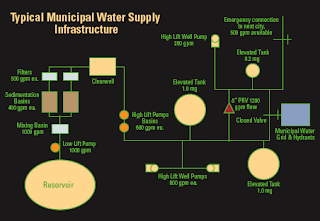Joe Weltner
Most people don’t think about where the water comes
from or how it gets to their faucets, they just consider it free and there for
the taking. Likewise, little thought is given to what happens to the wastewater
generated by private residences, institutions, commercial
buildings, and industries once it goes down the drain.
 Maintaining water treatment systems,
distribution lines and storage facilities, sewer treatment plants, pump stations, and
collection lines is costly. Much of the extensive network of water and
wastewater systems infrastructure is underground, going unseen and unnoticed
until something breaks. Managing these vital assets by careful maintenance,
Maintaining water treatment systems,
distribution lines and storage facilities, sewer treatment plants, pump stations, and
collection lines is costly. Much of the extensive network of water and
wastewater systems infrastructure is underground, going unseen and unnoticed
until something breaks. Managing these vital assets by careful maintenance,
monitoring, rehabilitation, renewal, and replacement strategies is essential to
ensure public access to water and sanitation and to protect public health and
the environment.
Life cannot exist without
water. In addition to drinking water, we depend on a safe and abundant water
supply for everything associated with the production of all the goods we
consume including our food and for basic hygiene. Despite water being necessary
for our survival, investments to maintain and upgrade the infrastructure that
assures continual safe delivery of potable water are in jeopardy because of
declining revenues and tightening budgets. The natural effects of time,
materials, capacity changes, poor installation, and corrosive soil and flow
contents require that the pipes be repaired or replaced to ensure that a
consistent quality of water be delivered to citizens. Similarly, expenses of
maintaining the mechanical elements of both the water and wastewater systems
are costly. Serious problems will be encountered if our water infrastructure is
not able to deliver to us our most valuable natural resource.
As knowledge about health risks
associated with various contaminants and disinfection by-products increases,
new regulations will continue to grow more stringent. Each new regulation
presents new challenges that typically require new sustainable methods and/or
technologies in order to meet or surpass the new requirements. The U.S.
Environmental Protection Agency (EPA) has stated a goal to increase enforcement
of water quality regulations, particularly Clean Water Act regulations dealing
with wet weather issues.
Delivery of water/wastewater services are
considered enterprise funds in which all cost of service delivery – direct,
indirect, and capital costs - are identified and paid for through fees that
make the entity self-supporting. Enterprise funds provide goods or services to the public for a fee that in
order to meet community needs. Sewer rates are based on water consumption
because the majority of water used goes down the drains and toilets ending up
in the sewer system.
Water/wastewater rate increases are necessary for
maintenance of existing infrastructure and equipment, maintenance and repair of
existing mechanical components, cost of chemicals, and payment of personnel.
Evans City’s water system infrastructure has one 750,00 gallon water tank,
which is replenished from a 10” water line from Pennsylvania American Water and
a new Sequential Batch Reactor (SBR) Plant to treat our wastewater. The wastewater
collection system includes a network of pipes and pumps that collect and
transport wastewater to the treatment facility. Wastewater entering the Plant
is called influent as it passes through screens which remove large solid
material, then to specialized tanks for grit removal, on to large settling
basins, then to clarifiers, and finally is chlorinated and de-chlorinated
before leaving the Plant. Sludge is collected from the bottom of the clarifiers
and is disposed of properly.
Operators of the water/wastewater
systems must be adequately trained and certified. They are on call 24 hours a
day, 7 days a week, 365 days a year, and are responsible for repairing
everything from pipe leaks and valves to electrical and instrumentation
equipment. This work becomes especially demanding during seasonal changes when
the ground moves causing water mains to break under the strain.
 When measured as a percentage
of household income, Americans pay less for water/wastewater bills than other
developed countries.Because of this, the public has
been led to believe that water is available and cheap. To meet essential
infrastructure needs, pricing that recovers the costs of building, operating,
and maintaining a system is absolutely necessary. Drinking water and wastewater
utilities must be able to price water to reflect the full costs of treatment
and delivery.
When measured as a percentage
of household income, Americans pay less for water/wastewater bills than other
developed countries.Because of this, the public has
been led to believe that water is available and cheap. To meet essential
infrastructure needs, pricing that recovers the costs of building, operating,
and maintaining a system is absolutely necessary. Drinking water and wastewater
utilities must be able to price water to reflect the full costs of treatment
and delivery.
.
Sources for
information used include the following:
http://water.epa.gov/infrastructure
